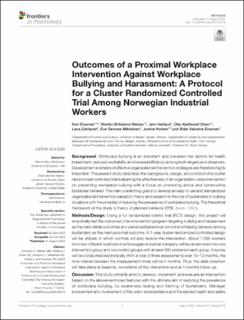| dc.contributor.author | Einarsen, Kari | |
| dc.contributor.author | Nielsen, Morten Birkeland | |
| dc.contributor.author | Hetland, Jørn | |
| dc.contributor.author | Olsen, Olav Kjellevold | |
| dc.contributor.author | Zahlquist, Lena | |
| dc.contributor.author | Mikkelsen, Eva Gemzøe | |
| dc.contributor.author | Koløen, Justine | |
| dc.contributor.author | Einarsen, Ståle | |
| dc.date.accessioned | 2021-03-12T09:59:27Z | |
| dc.date.available | 2021-03-12T09:59:27Z | |
| dc.date.created | 2020-09-02T11:39:04Z | |
| dc.date.issued | 2020-08-31 | |
| dc.Published | Frontiers in Psychology. 2020, 11:2013 1-12. | |
| dc.identifier.issn | 1664-1078 | |
| dc.identifier.uri | https://hdl.handle.net/11250/2733086 | |
| dc.description.abstract | Background: Workplace bullying is an important and prevalent risk factors for health impairment, reduced workability and lowered efficiency among both targets and observers. Development and tests of effective organizational intervention strategies are therefore highly important. The present study describes the background, design, and protocol of a cluster randomized controlled trial evaluating the effectiveness of an organization-wide intervention on preventing workplace bullying with a focus on promoting active and constructive bystander behavior. The main overarching goal is to develop an easy to use and standardized organizational intervention based on theory and research in the role of bystanders in bullying situations with the potential of reducing the prevalence of workplace bullying. The theoretical framework of the study is theory of planned behavior (TPB; Ajzen, 1991). Methods/Design: Using a full randomized control trial (RCT) design, this project will empirically test the outcomes of an intervention program targeting bullying and harassment as the main distal outcomes and perceived behavioral control and helping behavior among bystanders as the main proximal outcome. A 1-year cluster randomized controlled design will be utilized, in which controls will also receive the intervention. About 1,500 workers from two different locations of a Norwegian industrial company will be randomized into one intervention group and two control groups with at least 400 workers in each group. A survey will be conducted electronically. With a total of three assessments over 10–12 months, the time interval between the measurement times will be 4 months. Thus, the data collection will take place at baseline, completion of the intervention and at 4 months follow-up. Discussion: This study primarily aims to develop, implement, and evaluate an intervention based on the abovementioned features with the ultimate aim of reducing the prevalence of workplace bullying, by awareness raising and training of bystanders. Manager involvement and involvement of the union representative and the elected health and safety representatives is an important feature of the program. Results of the intervention study will provide important information regarding the effectiveness of preventive interventions against workplace bullying when focusing on bystanders, particularly so regarding the role of bystander awareness, bystander self-efficacy, and bystander behavioral control on the one hand and the prevalence of bullying and harassment on the other. | en_US |
| dc.language.iso | eng | en_US |
| dc.publisher | Frontiers | en_US |
| dc.rights | Navngivelse 4.0 Internasjonal | * |
| dc.rights.uri | http://creativecommons.org/licenses/by/4.0/deed.no | * |
| dc.title | Outcomes of a proximal workplace intervention against workplace bullying and harassment: A protocol for a cluster randomized controlled trial among Norwegian industrial workers | en_US |
| dc.type | Journal article | en_US |
| dc.type | Peer reviewed | en_US |
| dc.description.version | publishedVersion | en_US |
| dc.rights.holder | Copyright 2020 Einarsen, Nielsen, Hetland, Olsen, Zahlquist, Mikkelsen, Koløen and Einarsen | en_US |
| dc.source.articlenumber | 2013 | en_US |
| cristin.ispublished | true | |
| cristin.fulltext | original | |
| cristin.qualitycode | 2 | |
| dc.identifier.doi | 10.3389/fpsyg.2020.02013 | |
| dc.identifier.cristin | 1826682 | |
| dc.source.journal | Frontiers in Psychology | en_US |
| dc.source.40 | 11:2013 | |
| dc.source.pagenumber | 1-12 | en_US |
| dc.relation.project | Norges forskningsråd: 250127 | en_US |
| dc.identifier.citation | Front. Psychol. 2020, 11, 31 August, 2013 | en_US |
| dc.source.volume | 11 | en_US |

